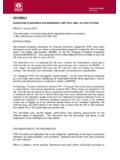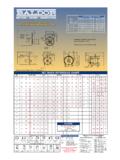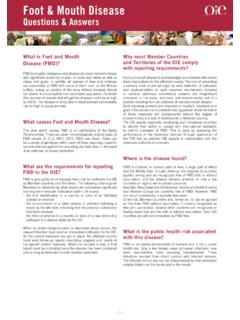Transcription of Foot Protection - Safeticorp LTD
1 foot Protection Training Guide LEATHER FACTS Grain: The smooth outer layer is the best and largest piece of leather on the animal. Used for better shoes, stay nicer looking longer and give more durability. Middle Split: This layer has no tensile strength and is used for very poor quality leather. Flesh Split: The bottom layer is used mainly for gloves, apparel and accessories. Many people refer to this layer as suede LEATHER CUTS Side: Side leather is the strongest portion of an animals hide.
2 In this area the fibers are more tightly woven and make the leather longer wearing. Shoulder: Shoulder hide is less uniform in density and appearance. Less durable but more affordable leather. Belly: The belly area yields the thinnest and least durable leather. All areas of the hide are graded during cutting, separated in to A, B or C grades in size and shape. SOLING SYSTEM UPPERS Full grain leather: The outer layer is printed or smoothly finished, breathable water resistant and bears a high abrasion resistance. The lower layer provides strength and has high moisture absorption capabilities.
3 Pull up leather: A full grain smoothly finished leather and oil tanned. The lower layer provides strength and absorption capabilities. Crazy horse leather: is a type of Pull up leather. Oil is applied under pressure at high temperature to achieve a rugged finish. Nubuck leather: The outer layer is lightly buffed, has a silky feel and is oil tanned for water resistance. The lower layer provides strength and absorption capabilities. Buffalo leather: Less durable and cheaper than cowhide. If it doesn't say what kind of leather it is, then it is probably Water Buffalo. Split leather: Suede layer has less durable and less breathable due to the stamping but is very cheap since multiple layers can be achieved from a single hide.
4 Action leather: A dry processed synthetic leather of which PU coated split leather. LINERS Textile: Textiles inserts ensure optimal climate management within the shoe. Ventilating, lightweight and fashionable appeal. Nylon mesh: Nylon mesh is an opened woven textile construction. Lightweight and maximum ventilation for cooling system. Cambrelle: A non woven synthetic fabric, comfort and abrasion resistance. Prevents the build up of bacteria that can cause mildew, rot and odor.
5 Cordura: Cordura offers outstanding durability and excellent resistance to tear and puncture. Gore Tex: A waterproof and breathable fabric. Outstanding moisture absorption and transfer. Thermally balancing. Nappa leather: Smooth finished upper layer. Lower layer provides strength and excellent absorption. SAFETY TOECAP MATERIALS Steel toecaps: Manufactured from high carbon steel and heat treated for maximum impact Protection . Aluminium toecaps: Manufactured from aluminium alloys to create light weight, hi impact toe cap Protection . 50 % lighter than traditional steel toecaps. Composite Toecaps: Manufactured from non metallic composite materials to create light weight.
6 Over 25% lighter than traditional steel toecaps. SAFETY TOECAP CLASSES Safety Range: 200 Joule rated safety toe caps are recommended for use in Agriculture, Mining and Quarrying, Bush undertakings, Building and Construction, Waterfront, Heavy Engineering, Freezing Works and Meat works. Protective Range: 100 Joule rated safety toe caps are recommended for use in Light Engineering, Transport, Storage, Communications and Light woodworking. INSOLE The insole is the interior bottom of a shoe which sits directly beneath the foot . Removable, replaceable and extra insoles are often added for comfort. Insoles are also sometimes referred to as footbeds, inner soles or innersoles.
7 Polyurethane (PUR): Excellent breathability, smooth rubbery feel, superior abrasion resistance and impact Protection . Ethylene Vinyl Acetate (EVA): A closed cell foam, lightweight, durability, abrasion resistance and impact absorbtion. Polyethylene (PE): A foamed polyethylene of closed cell construction. Laminated to other materials for increased reinforcement. Poly Vinyl Chloride (PVC): A polyvinylchloride foam compound. Odorless and water resistance. MIDSOLE The middle layer between the outsole and the insole of a shoe providing stability, flexibility, cushioning and durability to the foot . Foam: Particularly suitable for use as a midsole material for an athletic shoe, comprises polyethylene modified by an elastomer modifier and cross linked, preferably using a peroxide cross linking agent, to form a closed cell foam material which has superior strength properties, improved energy return and reduced sensitivity to temperature change.
8 Paperboard: A wood fiber, water resistance and permeability. Fiberboard: Good folding strength, stability, strong water resistance, fair elasticity and economy. Stainless Steel: safety midsole plates for safety footwear. OUTSOLE The outsole is the layer in direct contact with the ground. Natural Rubber (NR): Excellent slip resistance even at wet conditions. Nitrile Rubber (NBR): Excellent resistance to oils, abrasion, and ripping. Heat resistance up to 300 C Polyurethane (PUR): Excellent impact absorption. Lightweight and flexible. Heat resistance up to 130 C Thermo Plastic Urethane (TPU): Superior grip and abrasion resistance. Resistant to temperatures up to 130 C Will not mark floors.
9 Lighter than PU and Rubber. Poly Vinyl Chloride (PVC): Ease of processing and low cost has led to its increasing share of the footwear market. It is a good choice for casual or waterproof shoes and boots but does not have the traction or durability needed for high performance footwear. SIZING CHART Men 4 56789 10 11 Women 3 4 5 6 Length (mm) What should I know when I buy footwear for work? Good footwear should have the following qualities: The inner side of the shoe must be straight from the heel to the end of the big toe The shoe must grip the heel firmly The forepart must allow freedom of movement for the toes The shoe must have a fastening across the instep to prevent the foot from slipping when walking The shoe must have a low, wide based heel; flat shoes are recommended People buying footwear for work should take the following advice: Do not expect that footwear which is too tight will stretch with wear Have both feet measured when buying shoes.
10 Feet normally differ in size Buy shoes to fit the bigger foot Buy shoes late in the afternoon when feet are likely to be swollen to their maximum size Ask a doctor's advice if properly fitting shoes are not available Consider using shock absorbing insoles where the job requires walking or standing on hard floors When selecting footwear, one should remember that tight socks or stockings can cramp the toes as much as poorly fitted shoes. Wrinkled socks, or socks that are too large or too small, can cause blisters. White woollen or cotton socks may be recommended since colored socks cause skin allergies in some people. What should I know about the fit and care of safety footwear?










